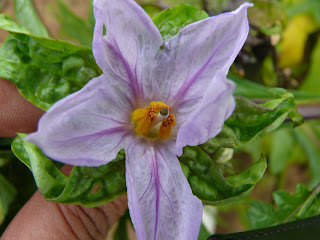B K Singh, K A Pathak, Y Ramakrishna, V K Verma and B
C Deka
ICAR
News: A Science and Technology Newsletter 16 (3): 5, 2010
Email: bksinghkushinagar@yahoo.co.in
Solanum macrocarpon (African eggplant/
nightshade) commonly known as Satinrem in Mizo language, had originated from the
wetter parts of tropical and subtropical Africa; where wild and cultivated
forms occur. In Indonesia and Malaysia, it is being cultivated from the sea
level to 600 m; and it has been somehow introduced in north-eastern states of
India. It is a glabrous, erect, branched, herbaceous, reaching up to 1.5 m with
blackish-violet stem that is woody at the base. Its flowers are complete,
actinomorphic, hermaphrodite and perfect. Anthesis occurs at about 5-8 AM. Fruits
are light-green when immature and are yellow-brown at maturity. It is
traditionally used as a leafy vegetable by Mizo community. Young leaves are usually
cooked and used in curry, meat and soup. Leaves are first harvested after 50-60
days of transplanting. Its fresh leaves have 4.3%
protein, 0.6% fat, 1.4% crude fibres, 1.3% ash and 89.7% moisture. Morphologically
and biologically Solanum macrocarpon
is very close to brinjal (Solanum
melongena). And this can be used as a genetic
resource for improving agronomic traits in brinjal.


This is a great post on Solanum macrocarpon and its importance in Mizoram’s diet and agro-biology. To maintain healthy leafy vegetables, farmers should consider reliable crop protection solutions—especially during humid conditions when pests and diseases are more active. Thanks for highlighting traditional crops and their nutritional value!
ReplyDelete